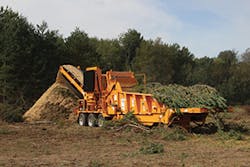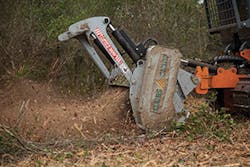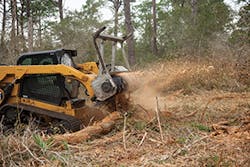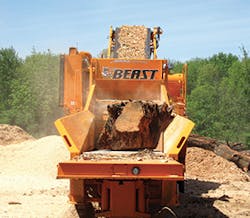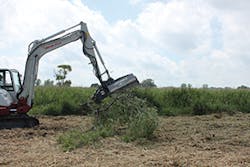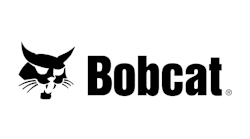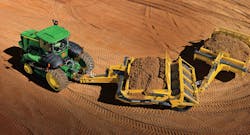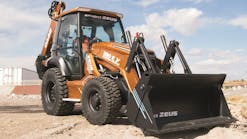Grading and excavating contractors that do site clearing are discovering equipment with the muscle to attack the most challenging jobs with speed, efficiency, and safety.
There are some differences of opinion, however, on such factors like carbide teeth on grinders. It boils down to personal preference and project conditions.
Mike Kachur, owner of Kachur Tree Services in Niles, MI, has found the Bandit Beast Recycler to be a productive partner on his job sites. His company does site clearing—among other tree-related services—with two crews.
Beast horizontal grinders from Bandit Industries Inc. are onsite grinders for land-clearing operations.
Kachur’s fleet includes a 765-horsepower Bandit Industries’ Beast 3680, a fifth-wheel unit with a 35-inch opening.
“We take that out on jobs such as work we do for municipalities and grind up waste or haul trees,” he says. “We like to grind trees with the stumps connected. Some guys cut the stumps off—I’m not sure why. It’s a lot easier to get the stumps through with the stump connected to the tree.”
Kachur recently purchased another 3680 Beast that is on tracks to access hard-to-reach areas.
“It’s for when the weather is not as good—when it’s more muddy and wet and hard to pull a wheeled unit in,” he says. “This will track in anywhere you want to go.”
Site clearing with a DENIS CIMAF DAF180E
Kachur favors the Bandit Beast for its carbide teeth.
“I’ve always had my eye on the Bandit Beast, being in the business and understanding grinding and what it takes to break wood down,” he says. “The carbide teeth have made production a lot easier. We started taking our own green waste and turning it into a product.”
There is a learning curve for those who have never learned how to make mulch or how to maintain the machine, says Kachur.
“These machines will treat you well if you do your maintenance, keep them clean, and keep an eye on the teeth,” he says, adding that his company doesn’t have to use a lot of teeth on its Bandit Beast.
Maintenance includes daily greasing. The company’s new unit is self-greasing, notes Kachur.
The Bandit Beast also has built-in computer screens indicating when the unit is idling, the amount of fuel being burned, fuel pressures, oil pressures, and feed rates, he adds.
Kachur also favors the unit’s technology that slows the feed rate down as the RPMs decrease.
Ultimately, Kachur’s company is deriving efficiencies from the machine’s use by keeping green waste out of landfills and creating a product for end-users who use it for landscaping, he says.
“Instead of using a leaf turner or windrow for leaf piles, what’s neat about our track grinder is we can pick the material up and throw it into our Beast grinder and it chops the material finer and gets it to rot faster by breaking it down,” says Kachur.
The traditional approach of windrows necessitates more space for the machinery, he adds.
Recent improvements to the Beast horizontal grinders: the augers include a trap door that allows for cleaning without separating infeed and plastic sheets, and have been upgraded to replaceable steel wear plates made from AR400 material, notes company spokesperson Paula Balhorn.
In the new flange-type auger, only the caps—not the shaft—are changed by unbolting and replacing them.
On the feed wheel, the stub shaft is designed as one piece. An extra-large feed wheel option is designed to provide better control of wood into the mill with the larger-diameter wheel keeping contact with the material until it is at the cutter head. The design also helps it climb material being fed, she notes.
Replaceable wear plates are standard on the wear side of the grinding chamber. The base door opening is larger. Cutter bodies no longer need be removed to remove or replace the cutter mill. The chamber hood that followed the circular pattern of the mill was eliminated, increasing production while eliminating a wear area.
A proportional drive option automatically adjusts the feed speed to the load that the engine is experiencing, enabling the mill to produce a finer end product as the feed speed slows.
If a larger product is desired, the proportional drive can be switched to the auto-feed drive, where the conveyor’s feed speed will match the mill speed and maintain the desired product size.
All teeth are now subject to a new brazing process for improved durability, says Balhorn. NR26 teeth are available, which utilize higher-grade carbide and are more wear-resistant when processing contaminated materials such as shingles and C & D waste.
With the exception of shingle teeth, all teeth can be mounted to the knife cutter bodies to allow more efficient changing from chipping to grinding, says Balhorn. Heavy-duty shingle rakers have been designed to be taller, wider, and made from wear-resistant material with a 6-weld pattern.
Forged rakers are designed to offer greater hardness and thickness in crucial areas.
A two-stage discharge conveyor was added to the 2680XP and 3680XP, along with a faster discharge conveyor speed to increase the discharge capacity of the machine to accommodate increased production.
The gate sizes of the 2680XP and 3680XP increased, with a 23% increase in the overall screening surface as well as an increase in the rate at which the material can exit the grinding area.
The proportional drive automatically senses mill/engine load and adjusts feed speed accordingly, providing a continuous, uninterrupted flow of material to the mill. As it may reduce the size of the end product due to slower feed speed, it is recommended for initial material breakdown as opposed to final grind, points out Balhorn.
The proportional drive can be turned off at any time to allow the standard auto-feed drive to operate with the auto-feed system.
DENIS CIMAF Inc. manufactures two models of industrial high-flow mulchers: the DAH and the DAF.
Both are based on the same technology but are attached to a different carrier type and have different strategies for mulching, notes the head of design and marketing, Pierre-Luc Boisvert.
The mulchers are designed to be attached to a boom-type carrier—mostly excavators—but also some feller-bunchers or other specialized carriers, notes Boisvert.
The company is unveiling eight different models of DAH in 2018, including the DAH-065B with a 26-inch cutting width designed for 8–10-ton excavators, and the DAH-150Er with a 57-inch cutting width for 27–35-ton excavators.
A DENIS CIMAF DAF 180D hard at work
The DAF family of mulchers is designed to be attached in front—or in some cases, behind—a dedicated carrier, notes Boisvert, adding that the carriers for the DAF are mostly skid-steer, tractor, or other types.
The mulchers’ rotors have fins on them limiting the amount of material, helping the mulch to stay small and uniform, he adds.
“It also requires less power than the hammer-style rotors,” says Boisvert. “We always say it’s better to cut down a tree with an ax, not a hammer.”
The company’s mulching equipment is in operation at Megan and Andrew Dial’s Ground Cover Clearing and Final Grade LLC in Covington, GA, as part of a fleet that includes a Cat 299D XHP with a DAF180D, a Cat 323F with a DAH125D, and a Timberpro TL725C with a DAH150ER.
The company’s two full-time employees work primarily in Georgia where heat and humidity take a toll on the equipment daily, notes Andrew Dial.
“We run into granite in the northern part of the state but only have a clean sandy soil in southern Georgia,” says Dial. “We have a mixture of yellow pine and various hardwoods. We clear mature trees typically where we produce a thick mulch bed, which allows us to get more than 300 hours out of type 3 teeth on the DAH heads. The 180D gets more than 200 hours on a set of type 3.”
A Bandit Beast chews up tree trunks
The company can clear an acre of terrain per day in an average of 10-inch diameter material on flat ground, says Dial.
The company’s primary clients are in the commercial sector.
“We work around delicate situations involving moving traffic and existing buildings,” says Dial. “The DENIS head discharges material in such a controlled manner that we don’t have to be constantly concerned about damaging property.
“Also, working commercially, our product is inspected and we never get turned down or called back. The DENIS head produces the finest finish available in the most efficient time frame.”
Dial says the DAH limited bite rotor enables his company to take down any size of material encountered.
“The combo of the knife and the limited bite rotor requires significantly less horsepower than a carbide/smooth drum to process the same size material,” he says. “The tilt coupler assists while working against fence lines or similar obstacles by being able to tilt the working end of the mulching head away from the inherent danger.
Putting a Loftness Battle Ax to work
“It’s easier to keep the knives out of the dirt when working on the ground. It allows for safer tree felling with the added control. Overall, it increases productivity.”
In terms of operation and maintenance, Dial says his company spends more time working on the carrier than on the head.
“With the exception of knife replacement, there is virtually no continuous maintenance cost on the mulching head.”
Other options in the market include the Loftness VMLogix line of vegetation management equipment, which includes hydraulic oil coolers, the Kwik-Trim compact mechanical tree trimmer, and high-performance mulching heads for a variety of equipment, ranging from skid steer loaders to 400-horsepower prime movers.
The company recently introduced its Battle Ax mulching head with a rotor design using depth gauges instead of a traditional ring design to limit material flow into the drum.
Bill Schafer, product development supervisor for Loftness, points out that the vegetation management industry has recently experienced changes regarding the use of mulching heads on skid steers, excavators, and other power units.
The design of mulching heads has changed accordingly to better accommodate operators, “helping them become more productive and create a better finish,” he adds.
One of the latest trends affects the cutting tooth.
“For many years, carbide cutting teeth were the most popular tooth option for mulching heads,” points out Schafer. “That’s because they’re highly durable, cost-effective, and virtually maintenance-free. As a result, many mulching heads were once optimized for the use of carbide teeth.”
Of late, the shift has been toward the use of knives on mulching heads, he says.
“Although they need to be sharpened regularly and have a heightened risk of damage when striking rocks and other foreign objects, knives offer unmatched aggressiveness that can provide a big productivity boost on the job,” says Schafer. “Also, the use of sharpened knives naturally results in a finer particle size, providing a more attractive finished product for the customer.”
Rotors have gone through redesigns as well.
“As knives are gaining popularity in recent years, manufacturers have responded with newer mulching head rotor designs that better accommodate the performance of knives,” says Schafer. “Because the knives are so much more aggressive than carbide teeth, some of the newer rotors are larger in diameter and often include some type of limiter to keep the knives from biting into too much material at one time.”
Depth gauges are a different approach to controlling the amount of material being fed into the mulching head, notes Schafer.
The depth gauges, which are welded onto the rotor in front of the cutting teeth, function similarly to raker teeth on chainsaws, he says.
“Although they do help prevent the teeth from taking in too much material at one time, the depth gauges offer added flexibility, allowing operators to bite into material more aggressively when needed,” points out Schafer.
While ring-style limiters have been on the market for a longer amount of time, depth gauges were recently introduced to help improve some of the shortcomings that vegetation management professionals have experienced with ring limiters, he says.
“For instance, some find mulching heads with rings to be overly limiting,” says Schafer. “After a tree or branch is knocked down and the operator backs over it for mulching, the rings can hinder the ability to pick the material off the ground for proper cutting. On the other hand, depth gauges improve the ability to bite into material and pick it off the ground for mulching.”
Although knives have increased in popularity on mulching heads, many contractors still desire the ability to switch to carbide teeth as conditions require, such as operation in rocky terrain.
“While all styles of rotors allow users to switch between knives and carbide teeth, not all rotors perform equally with different teeth,” he says. “One common experience with ring-style rotors is that they do not seem as compatible with carbide teeth. The limiting design of rings, combined with the reduced aggressiveness of carbide teeth, tends to limit performance of the mulching head. This occurrence is especially noticeable when mulching material off the ground. Carbide teeth generally do not pick up the material as well.”
Depth gauges are engineered to address this issue, says Schafer.
“Many end-users find that this newer style of rotor improves performance and picks up material better when using carbide teeth,” he says. “This is a major advantage of depth gauges since most of the work with a mulching head is done back-dragging over material on the ground.”
Acknowledging purchase decisions for mulching heads comes down to personal preference, Schafer notes that the introduction of depth gauges “offers a fresh alternative to maximize the use of both sharpened knives and carbide teeth.”
Loftness recently introduced the Battle Ax mulching attachment for 7–15-ton excavators to its VMLogix product line.
It features a new rotor, two-stage cutting chamber, and direct-drive variable displacement piston motor.
The Battle Ax is designed for optimal vegetation management efficiency, including right-of-way maintenance, land clearing, forestry applications, and more.
The Battle Ax is available with 41-, 51-, and 61-inch cutting widths. Its 17-inch-diameter rotor features built-in depth gauges, which function similarly to raker teeth on chainsaws, to prevent the attachment from engaging too much material at one time.
Quadco reversible knives and highly durable carbide teeth are available as options. A two-stage cutting chamber enables material to be cut twice by the rotor. Both styles of teeth are designed to produce significantly small particle sizes. The primary shear bar is adjustable for customizing particle size.
Standard features include a spade hook, adjustable skid shoes that allow cutting up to 1.5 inches below grade, anti-wrap bearings, premium strength steel housing, and steel deflector chains.
Custom mounts are available for all excavators. A self-contained hydraulic thumb is also optional for contractors that don’t wish to use the factory excavator thumb.
Vermeer recently launched the HG6800TX horizontal grinder and WC2500TX whole tree chipper to add to its line, which includes the established FT300 forestry tractor for an umbrella solution for land clearing.
The HG6800TX was built for land clearing and pipeline right-of-way operations, offering a 950-horsepower engine on a tracked horizontal grinder, notes Matt Eul, Vermeer’s product marketing specialist for Recycling and Forestry.
A John Deere 470F LC doing the heavy lifting
“The newly designed infeed table offers low side walls, aiding in feeding whole trees and other larger materials with less interaction required from the operator,” he says. “The WC2500TX is a tracked whole-tree chipper, allowing users to maneuver in the woods and tough land-clearing sites.
“The FT300 forestry tractor was built for the toughest land-clearing demands. The dedicated mulcher offers a robust hydraulic system designed to operate below its rated capacity for extended life of hydraulic components.”
The HG6800TX has the option to come equipped with Vermeer’s new Damage Defense.
“The new technology is ideal for any type of tub or horizontal grinder operation that may encounter certain metal contaminants mixed in with their incoming materials,” says Eul. “If the mill comes in contact with metal while grinding, the Damage Defense system will alert the grinder control and automatically initiate the shutdown process.”
David Young, product marketing manager for excavators at John Deere Construction & Forestry, notes that the company’s units are designed with hydraulic smoothness.
“It offers the operators the ability to operate comfortably for long periods of time and remain productive while being comfortable,” he says.
John Deere has also designed its excavators to deal with a mass excavation project for productivity and efficiency, adds Young.
They offer 13 mid-sized excavators and three large ones that are best suited for site clearing work, he says.
Of note are the 470G LC—a 367-horsepower excavator with a maximum digging depth of 27 feet and two inches—and the 350G LC with net power of 271 horsepower at 1,900 RPM and a maximum digging depth of 26 feet and 10 inches.
Operator comfort is key on a job site, points out Young.
John Deere has created spacious cabs, ergonomically-friendly seats, air conditioning, and visually attractive monitors that are well-placed to enhance operators’ visibility, including the external environment.
John Deere also offers rearview cameras to augment visibility.
Additionally, the standard JDLink technology provides operators with information regarding fuel usage, diagnostics, machine health information, and GPS.
Two of the most popular attachments for the John Deere excavators for site clearing include compactor and hammer attachments, says Young.
Gregg Zupancic, product marketing manager for skid steers and compact track loaders, John Deere Construction & Forestry, notes that the equipment is designed to be versatile in terms of the number of different tasks that can be accomplished with attachments.
“We’re seeing a very strong trend towards compact track loaders with high-flow capacity hydraulic attachments for cleaning up downed trees or shrubbery,” says Zupancic. “They use quite a few mulching heads and can grind up trees up to 12 inches in diameter and turn them to mulch on the job site.”
Attachments such as extreme-duty rotary cutters are used to tackle 7–8 inches of width in terms of cutting trees, he says.
“They’re quicker at cutting through shrubbery,” says Zupancic, adding that they resemble a deck mower.
Zupancic says mulching heads—when coupled with a compact track loader that works well in soft ground conditions, brush ground conditions, or steep terrain—are in demand.
John Deere also offers a front grapple that has been used to help with cleanup efforts in recent natural disaster areas, he adds.
John Deere machines are equipped with switchable controls for three different control patterns within one machine, he adds.
The company has also designed technology with settings to speed up or slow down buckets or attachments; the boom arms have three different settings to speed up or slow down the boom.
“If you’re really experienced and have high productivity, you keep it on the fastest speed,” says Zupancic. “If you are a newer operator, you could set it to a slower speed.”
Settings can be configured to the point where if an operator or multiple operators get into the machine and use certain control patterns, “when he starts the machine, he types in his own unique operator code and the machine will automatically configure itself to the last settings he had used on that machine,” he says, adding that it can accommodate up to five different operators.
There are more settings for mulching or land clearing, says Zupancic.
“It gets pretty dusty and the coolers of the machine need to stay clean, so you can set the reversing fan interval to blow out those coolers without having to stop and clean them off manually,” he says.
“Those intervals are also programmable to have it go off as needed for the operators depending on the application. It would automatically set itself up to what the operator programmed it when he was running the machine,” adds Zupancic.